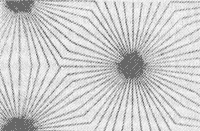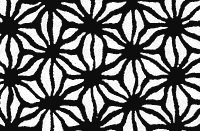Cànem o coral?
L’estampat sobre cotó (calico-printing) va ser introduït a Gran Bretanya de la Índia en 1676, 150 anys abans de Barcelona. Un home anomenat Lane es va enriquir en el Manchester del segle dinou amb un patró del com Hugh Miller, escrivint en 1852, diu que El Vell de Dalt tenia els drets. Per a Miller no és suficient que el Sr Lane va finançar la construcció del meravellós Corn Exchange de Manchester (1836, preu: £3.250). De totes maneres, el patró em sembla més al cànem que a un coral. La meva traducció:
En un article sobre l’estampat sobre cotó, que forma part d’una història recent de Lancashire, hi ha alguns dels patrons introduïts, suportats per la recomanació que van ser els més reeixits de la història. D’un d’aquests, conegut com ‘Lane’s Net’, es van vendre un major nombre de peces que de qualsevol altre patró introduït al mercat. Va conduir a moltes imitacions; i un del més popular d’aquests contesta línia per línia al patró en el coral de gres vermell antic recent descobert, el Smithy Pengellyi, excepte que és més rígid i rectilini. Les línies meravellosament disposades, que havien estat estampades enmig de les roques eons de d’edats abans, van afectar tant a les dames d’Anglaterra, que cadascuna havia de proveïr-se ella mateixa d’un vestit de la tela que van adornar. I no s’ha d’oblidar, que totes aquestes formes i matissos de bellesa que una vegada van omplir la naturalesa i de les que només sobreviuen alguns fragments o tints descolorits, van ser creats no per a satisfer l’amor de l’home per l’estètica, considerant que l’home no tenia cap existència fins molt temps després que aquests haguessin desaparegut, si no en una harmonia apropiada amb els gustos i les facultats del Treballador Diví que en la seva saviesa les va produïr totes.
(In an article on calico printing, which forms part of a recent history of Lancashire, there are a few of the patterns introduced, backed by the recommendation that they were the most successful ever tried. Of one of these, known as ‘Lane’s Net’, there sold a greater number of pieces than of any other pattern ever brought into the market. It led to many imitations; and one of the most popular of these answers line for line, save that it is more stiff and rectilinear, to the pattern in a recently-discovered Old Red Sandstone coral, the Smithy Pengellyi. The beautifully arranged lines which so smote the dames of England, that each had to provide herself with a gown of the fabric which they adorned, had been stamped amid the rocks eons of ages before. And it must not be forgotten, that all these forms and shades of beauty which once filled nature, but of which only a few fragments, or faded tints, survive, were created, not to gratify man’s love of the aesthetic, seeing that man had no existence until long after they had disappeared, but in meet harmony with the tastes and faculties of the Divine Worker, who had in his wisdom produced them all.)
De The Testimony of the Rocks, or Geology in its Bearings on the Two Theologies, Natural and Revealed de Hugh Miller (1857, escrit 1852). Citat en Humphrey Jennings, Pandæmonium 1660-1886: The Coming of the Machine as Seen by Contemporary Observers. Gràcies a la Angie per suggeriments sintàctics.

Lane’s Net

Smithia Pengellyi

Cànem (Jeanne Allen, The Designer’s Guide to Japanese Patterns)
Similar posts
Back soon
Comments